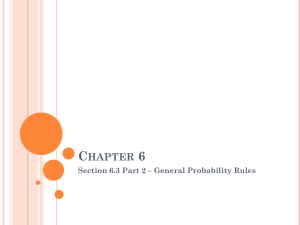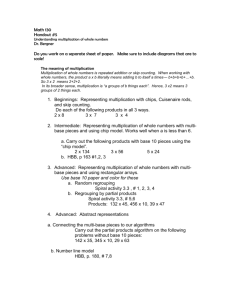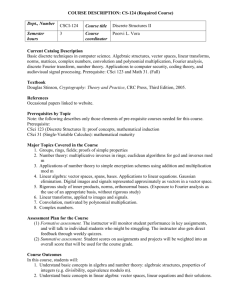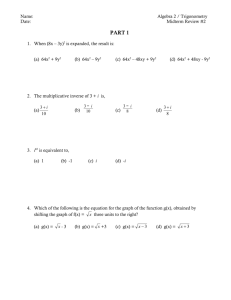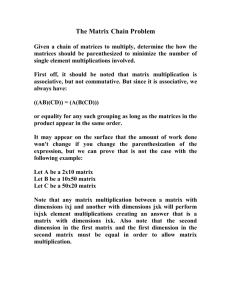Distributive Property Using a Multiplication Table
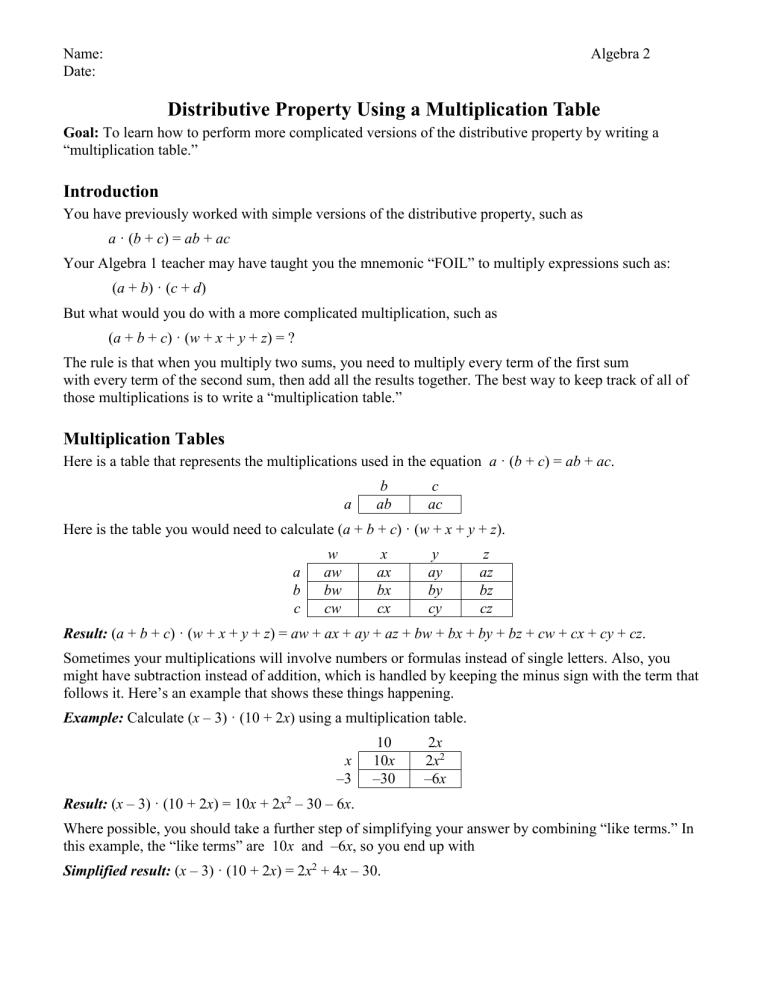
Name:
Date:
Algebra 2
Distributive Property Using a Multiplication Table
Goal: To learn how to perform more complicated versions of the distributive property by writing a
“multiplication table.”
Introduction
You have previously worked with simple versions of the distributive property, such as a · ( b + c ) = ab + ac
Your Algebra 1 teacher may have taught you the mnemonic “FOIL” to multiply expressions such as:
( a + b
) · ( c + d )
But what would you do with a more complicated multiplication, such as
( a + b + c
) · ( w + x + y + z ) = ?
The rule is that when you multiply two sums, you need to multiply every term of the first sum with every term of the second sum, then add all the results together. The best way to keep track of all of those multiplications is to write a “multiplication table.”
Multiplication Tables
Here is a table that represents the multiplications used in the equation a · ( b + c ) = ab + ac . b a ab c ac
Here is the table you would need to calculate ( a + b + c
) · ( w + x + y + z ). w a aw b bw c cw x ax bx cx y ay by cy z az bz cz
Result: ( a + b + c
) · ( w + x + y + z ) = aw + ax + ay + az + bw + bx + by + bz + cw + cx + cy + cz .
Sometimes your multiplications will involve numbers or formulas instead of single letters. Also, you might have subtraction instead of addition, which is handled by keeping the minus sign with the term that follows it. Here’s an example that shows these things happening.
Example: Calculate ( x – 3) · (10 + 2 x ) using a multiplication table.
10 2 x x 10 x 2 x 2
–3 –30 –6 x
Result: ( x – 3) · (10 + 2 x ) = 10 x + 2 x
2
– 30 – 6 x .
Where possible, you should take a further step of simplifying your answer by combining “like terms.” In this example, the “like terms” are 10 x and –6 x , so you end up with
Simplified result: ( x – 3) · (10 + 2 x ) = 2 x
2
+ 4 x – 30.
Name:
Date:
Classwork Problems
Algebra 2
1.
Calculate each of these products by filling in the multiplication tables. The first is an example.
a.
EXAMPLE: ( x + 3) · ( x + 6) = x
2 +
3 x
+
6 x
+
18
= x
2 +
9 x
+
18 x x x
2
3
3 x
6 6 x 18 b.
( a – 4) · ( a + 2) = __________________________________ c.
(2 n – 5) · (3 n – 4) = _______________________________ d.
( a + b
) · ( a + b ) = __________________________________ e.
( x + 3) · ( x 2 + 2 x – 8) = _____________________________
Name:
Date:
2.
Calculate using a multiplication table. Write an equation. Simplify where possible.
Algebra 2 a.
( x
2
+ 4 x – 3) · x = _____________________________________ b.
( x
5
+ x
2 ) · ( x
3
+ x
6
) = _________________________________________ c.
(2 k – 1) · (3 – k ) = __________________________________________ d.
( ax
2
+ bx + c
) · ( x + 2) = ____________________________________________ e.
( x + 1
2
) · ( x – 1
3
) = ________________________________________________
Name:
Date:
3.
Calculate using a multiplication table. Write an equation, then simplify.
In these problems, something unusual happens in the simplifying step. a.
( x – 3) · ( x + 3) = _______________________________________ b.
( a + b
) · ( a – b ) = _______________________________________ c.
(– n + 2) · ( n + 2) = ______________________________________ d.
(2 x + 3 y
) · (2 x – 3 y ) = ______________________________________
Algebra 2
4.
a.
Explain the unusual thing that happened in the simplifying step for the four problems on this page. b.
Make up a multiplication problem of your own where the same thing would happen.
Show the multiplication table and write an equation.
Name:
Date:
Algebra 2
Check Your Answers
1. b.
( a – 4) · ( a + 2) = a 2 + 2 a – 4 a – 8 = a 2 – 2 a – 8 c.
(2 n – 5) · (3 n – 4) = 6 n
2
– 8 n – 15 n + 20 = 6 n
2
– 23 n + 20 d.
( a + b
) · ( a + b ) = a
2
+ ab + ba + b
2
= a
2
+ 2 ab + b
2 e.
( x + 3) · ( x
2
+ 2 x – 8) = x
3
+ 2 x
2
– 8 x + 3 x
2
+ 6 x – 24
= x
3 +
5 x
2 -
2 x
-
24
2. a.
( x
2
+ 4 x – 3) · x = x
3
+ 4 x
2
– 3 x b.
( x
5
+ x
2 ) · ( x
3
+ x
6
) = x
8
+ x
11
+ x
5
+ x
8
= x
11
+ 2 x
8
+ x
5 c.
(2 k – 1) · (3 – k ) = 6 k – 2 k
2
– 3 + k = – 2 k
2
+ 7 k + 3 d.
( ax
2
+ bx + c
) · ( x + 2) = ax
3
+ bx
2
+ cx + 2 ax
2
+ 2 bx + 2 c e.
( x + 1
2
) · ( x – 1
3
) = x
2
– 1
3 x + 1
2 x – 1
6
= x
2
+ 1
6 x – 1
6
3.
a.
( x – 3) · ( x + 3) = x
2
+ 3 x – 3 x – 9 = x
2
– 9 b.
( a + b ) · ( a – b ) = a 2 – ab + ab – b 2 = a 2 – b 2 c.
(– n + 2) · ( n + 2) = – n
2
– 2 n + 2 n + 4 = – n
2
+ 4 d.
(2 x + 3 y
) · (2 x – 3 y ) = 4 x
2
– 6 xy + 6 xy – 9 y
2
= 4 x
2
– 9 y
2
4.
a.
In each part of problem 3 , two of the four terms are opposites of each other so they cancel out, leaving only two terms in the final answer. b. Use any part of problem 3 as a model. Change the letters and/or numbers, but leave the + and – signs as they are. That will ensure getting two opposite terms that cancel.




